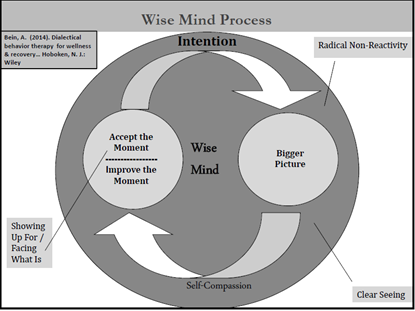5 Steps of the Wise Mind Process: Strategies for Facing Difficulties
Help clients manage their emotions with this DBT strategy

Debra is stressed about not having a job. In session she expressed the cycle of emotions that she’s stuck in.
She starts by thinking about all the steps she needs to take to get a job but gets overwhelmed. This would lead to despair and defeatism, thinking “no one would want to hire me anyway.”
Once those emotions were ramped up, she’d start thinking about her mother and brother never supported her. In an attempt to address that, she would call them up seeking validation to alleviate this despair. But eventually her family would grow impatient and tell Debra to spend the time looking for a job instead of calling them to complain.
This resulted in Debra being angry about their non-validating responses and she began to have thoughts of “what’s the point?” and “nobody gets it.” Which brings us back to this cycle of thoughts.
So how do we move forward in therapy?
In the cognitive approach, we want to normalize how difficult it is. Head off the despair and defeatism with the Wise Mind Process.
Wise Mind is a synthesis of reasonable mind and emotional mind.
Wise Mind allows us to move into our frontal cortex where we can integrate the hope and passion that provides richness in our life with rational, non-impulsive decision making that helps us stay safe and see life clearly. As we practice wise mind living, we notice that our wise mind helps us stay happier, more contented, more centered, and less anxious.
The practitioner’s primary role is to help the client be mindful of the moment, respond to the moment, and expand the moment.
Mindful: Accept the moment, observe & notice the moment, and be in the moment.
Respond: Improve the moment and let go of the emotional charge of the moment, be response-able in the moment – self-soothe, engage in positive action, do opposite action.
Expand: Find meaning in the moment and connect to bigger picture, love, or spirituality in the moment.

Now that your client is aware of their emotions and the facts of the problem, lets improve the moment with the following exercise. Use this Dealing with Judgment worksheet with clients to help them identify their judgements that keep them stuck, accept that it is there, and then let them go.
Download the worksheet and watch Dr. Andrew Bein, a seasoned instructor with an energetic, hands-on approach to mindfulness-based practices and Dialectical Behavior Therapy education, demonstrate the Dealing with Judgement exercise here.
She starts by thinking about all the steps she needs to take to get a job but gets overwhelmed. This would lead to despair and defeatism, thinking “no one would want to hire me anyway.”
Once those emotions were ramped up, she’d start thinking about her mother and brother never supported her. In an attempt to address that, she would call them up seeking validation to alleviate this despair. But eventually her family would grow impatient and tell Debra to spend the time looking for a job instead of calling them to complain.
This resulted in Debra being angry about their non-validating responses and she began to have thoughts of “what’s the point?” and “nobody gets it.” Which brings us back to this cycle of thoughts.
So how do we move forward in therapy?
In the cognitive approach, we want to normalize how difficult it is. Head off the despair and defeatism with the Wise Mind Process.
Wise Mind is a synthesis of reasonable mind and emotional mind.
Wise Mind allows us to move into our frontal cortex where we can integrate the hope and passion that provides richness in our life with rational, non-impulsive decision making that helps us stay safe and see life clearly. As we practice wise mind living, we notice that our wise mind helps us stay happier, more contented, more centered, and less anxious.
The practitioner’s primary role is to help the client be mindful of the moment, respond to the moment, and expand the moment.
Mindful: Accept the moment, observe & notice the moment, and be in the moment.
Respond: Improve the moment and let go of the emotional charge of the moment, be response-able in the moment – self-soothe, engage in positive action, do opposite action.
Expand: Find meaning in the moment and connect to bigger picture, love, or spirituality in the moment.

Step 1: Developing the intention to live in Wise Mind to enhance wellness
- Inclining the mind toward non-reactivity, calmness, and present-focused awareness
- Cultivating commitment; having a willingness and disposition to focus effect
- Assess/orient self in the moment with questions: “Am I in Wise Mind?” / “How can I practice Wise Mind now?"
Step 2: Accepting what arises
- Mindfully noticing emotions, thoughts, and situations without reacting
- Connecting with language that helps you accept: radical non-reactivity, facing what is, showing up for what is: all mean facing the truth of what is
- Tuning into breath to assist
Step 3: Improving the moment
- Accepting may mean that thoughts and feelings have less hold on you
- Letting go and releasing
- Seeking support
- Engaging in positive individual or social action
- Choosing healthy forms of soothing or distraction
Step 4: Expanding the moment/Accessing the bigger picture
- Connecting spiritually to help deal with troubling emotions, thoughts or situations
- Giving problems away to your higher power or “the universe”
- Thinking about how you & your recovery inspires others
- Sensing how you belong in this world and are loved
- Exploring your deepest purpose in the world
Step 5: Generating self-compassion for support
- Touch the vulnerability – “the ouch that hurts”
- Finding the patient, loving and compassionate part of yourself that appreciates who you are and recognizes that you will not be perfect
- Maintaining awareness that evaluating and measuring yourself may affect self-esteem but jeopardizes self-compassion
- Consciously tapping into self-compassion enhances wellness and recovery
Now that your client is aware of their emotions and the facts of the problem, lets improve the moment with the following exercise. Use this Dealing with Judgment worksheet with clients to help them identify their judgements that keep them stuck, accept that it is there, and then let them go.
Download the worksheet and watch Dr. Andrew Bein, a seasoned instructor with an energetic, hands-on approach to mindfulness-based practices and Dialectical Behavior Therapy education, demonstrate the Dealing with Judgement exercise here.
Dialectical Behavior Therapy Certification (C-DBT): Practical Clinical Applications for Trauma, Comorbidities, Addiction and More

DBT is one of the most clinically proven methods of therapy for most mental health conditions. This online certification course is grounded in the foundational principles of DBT. You’ll get updated DBT interventions to treat borderline personality disorder, anxiety, depression, trauma, suicidal ideations, addiction and nearly any client condition. Earn up to 27 CE Hours. Master DBT today – and become Certified in Dialectical Behavior Therapy (C-DBT)! Join an elite community of colleagues and significantly grow your practice and change your clients’ lives today.
Meet the Expert:
Andrew Bein, Ph.D., LCSW, has, for 20 years, been implementing mindfulness-based practices and Dialectical Behavior Therapy at a variety of practice settings. In a manner responsive to clinician, client and contextual realities, he has launched and contributed to DBT integration at the following settings: community mental health, outpatient dual diagnosis, women’s substance abuse, crisis residential, and high school and he has incorporated DBT into his private practice for individual and group treatment.
Learn more about his educational products, including upcoming live seminars, by clicking here.
Learn more about his educational products, including upcoming live seminars, by clicking here.





